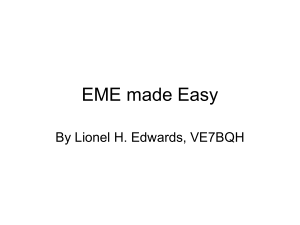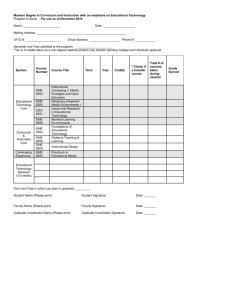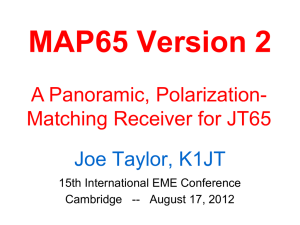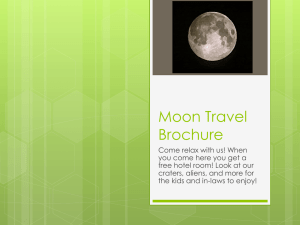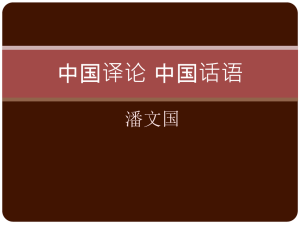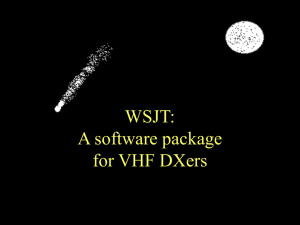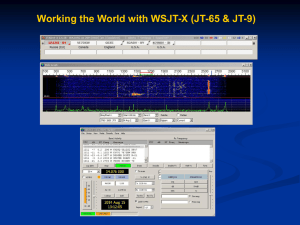Moon Bounce For QRPers
advertisement
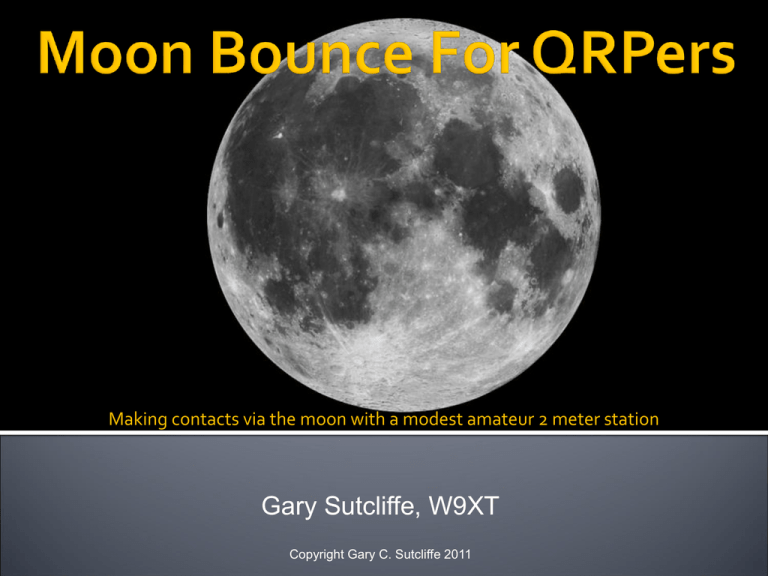
Making contacts via the moon with a modest amateur 2 meter station Gary Sutcliffe, W9XT Copyright Gary C. Sutcliffe 2011 EME involves transmitting a signal towards the moon and receiving the reflected wave. This allows worldwide contacts on frequencies where contacts are normally line of sight only. • • • • • Average distance to moon ~240,000 miles 2.4 second radio signal round trip Moon apparent size ~0.5º Moon reflects only ~7% of signal Average 144 MHz path loss: ~250 dB • • Ratio of 10,000,000,000,000,000,000,000,000 : 1 Difference between1KW and 0.1μW is only 100dB, 2KW and 0.1μW is 103 dB • You could make a 250 dB attenuator for 2M with 3.14 miles of LMR 400 Coax • If US power grid had these losses, you would have to multiply the total generating capacity by 10 Billion to get one watt out • Moon moves • Need to move antenna AZ/EL to track • Doppler shift in frequency • • • • Distance variation adds additional losses Ionospheric absorption can add more loss Faraday rotation skews polarization Cosmic & solar noise interferes with signal EME may be the biggest technical challenge in Ham Radio! • • • • • High power Big antennas Low loss coax, good connectors, etc. Low noise receivers & pre-amps Special techniques GAIN LOSS • • • • • Power out Transmit antenna Receive antenna Receiver gain • • Transmitter feed line loss Path loss Receiver feed line loss Σ(gains) – Σ(losses) > Noise • • • • 6M - Once thought to be impossible because of antenna size, but gaining popularity 2M - Most popular band mostly because of availability of equipment 432 & 1296 MHz - Most popular after 2M. Lower noise levels but not much commercial equipment available. Higher microwave bands are for the really dedicated EMEers. Photo courtesy of Dave Blaschke, W5UN W9GA Photo Left: 8 X 8 Element, 2M Right: 7’ dish, 1296 MHz Photos courtesy of Larry Molitor, W7IUV Equipment: Yaesu FT-847 All mode transceiver Mirage B2518G 150W 2M amp Cushcraft 13B2 13 element Yagis (2) CATV 75Ω hardline Dell PC running XP Unified Microsystems SCI-6 PC I/F Is moon bounce possible with such a small station? Equipment: Kenwood TS-711 2M All mode transceiver Henry 2002 2M KW amp 2 X 9 el M2 Yagis, hand aimed (not shown) M2 preamp Laptop PC • • • • • • WSJT – “Weak Signal Joe Taylor” Free PC Program Suite Uses special DSP techniques Modulation optimized for weak signal modes Dig out signals deep in noise JT-65 optimized for EME • • • • Low data rates Single tone per character Narrow bandwidth Decode calls to about -28dB, reports to about -30dB Signal Received: DL5BBW ES3RF KO29 OOO Signal -22dB – A strong one! Stations alternate 1 minute transmissions: Station 1 Transmission CQ W9XT EN53 Station 2 Transmission W9XT DX1XX ZZ99 DX1XX W9XT OOO RO RRR 73 Each station transmits the current sequence until it receives the full response. Many EME QSOs are scheduled on Ping Jockey W9XT • • • ~ 40 QSOs ~16 DXCC countries A few new west coast states There are several dozen big EME stations capable of working 100 watt single Yagi stations These stations are always looking for new stations to add to their “initial contact” list • W9XT future station plans • 4 Yagi array • Amplifier • Goals • 2M WAS (37 states worked, most terrestrial) • DXCC (16 countries worked) • • • • • • Long horizontal Yagi SSB transceiver w/100 watts PC PC sound card interface WSJT Program Work at moon rise/set • Get about 6 dB ground gain • Don’t need elevation rotor Plus a big gun station at the other end! Are you able to do EME with your station? WSJT Download: www.physics.princeton.edu/pulsar/K1JT/ N0UK Ping Jockey page: www.chris.org/cgi-bin/jt65emeA Moon-Net Internet mailing list: http://www.nlsa.com/nets/moon-nethelp.html DF2ZC 2M EME Newsletter: www.df2zc.de/newsletter/index.html News DXpedition schedules Best condition calendar Unified Microsystems: www.unifiedmicro.com Inexpensive PC sound card to radio interface kit Bounce VHF signals off meteor trails Range out to about 1400 miles Most activity 6 and 2 Meters Smaller station 50 watts & small Yagi Uses WSJT FSK441 mode Optimized for short bursts (~250 msec to transmit exchange) 30 second transmission sequences Best during meteor showers but high success rate with random meteors Moon and Earth Images: NASA Goldstone Antennas: NASA Station and antenna pictures: Dave Blaschke, W5UN Larry Molitor, W7IUV Ken Boston, W9GA This presentation is posted at www.w9xt.com www.unifiedmicro.com
